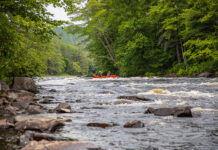Waiting near the Via Rail train station in Bathurst, New Brunswick, digging down in my pocket scrounging enough change for a cup of coffee, my hand emerged a few bucks richer and with flakes of aromatic cedar shavings.
I was on my way home from visiting Bill Miller, the dedicated canoe builder whose father helped pioneer a style of East Coast river canoe in 1925, and already the memories were falling all over the ground. What’s so special about wooden canoes and their builders is when you leave the shop, you go with a sliver of their craft. The aroma of cedar and varnish, a dusty hat, and a few token brass tacks jingling in my pocket are a reminder of the magic of wooden canoes.
In our world of carbon fiber gunwales, tough stuff hulls, and sub-30-pound canoes, it’s easy to forget the origins of these new-age boats, and to glance over the passing generations who toiled over the crafts we adore.
When Miller built his first canoe, it was off a mold his grandfather, William Vic Miller, had hued out with an ax at his home on the Tobique River in Nictau, New Brunswick. Miller Canoes were designed with a purpose—to pole sportsmen and freight up or down the shallow, swift rivers nearby. This meant a hull wide enough to stand and maneuver from, and enough length and depth to displace heavy loads through rapids.
A wood canoe begins well before the shop. In the case of Miller’s boats, the first stage starts in the woods behind his home. Each time a canoe is purchased, Miller walks to his backyard, chainsaw in hand, studies a cedar which he has often watched grow up, and admires its straight grain and lack of visible knots. When Miller fells what he refers to as “a perfect canoe tree,” the life of another has begun.
From the mill to the planer, every bit of the canoe, save brass tacks and marine varnish, is created in the workshop. Seats are hand fastened and meticulously caned, gunwales are cut from 21-foot spruce or ash tree lengths. Every detail is hand manipulated by an old-time master.
There are still workshops where these experiences are lived on the daily, places such as Headwater Canoes, Bear Mountain Boats, and in Miller’s dusty, 94-year-old shop. There’s a feeling of homecoming here, like a church on Sunday or the river when the level is just right.
I’ve been back to spend time with Bill Miller every year since my first visit some six years ago, and I’ve collected quite the arsenal of treasures from his gold chest of a canoe shop. From handcrafted bird’s eye maple paddles he helped me shape, to a miniature 15-foot Miller I paddle and adore when visiting my family’s home in the Ottawa Valley.
There’s nothing, however, I treasure as much as the little Ziploc bags full of shavings I’ve collected from the shop, or my dusty Miller Canoes hat. For every time I catch their whiff, I’m reminded of life’s important, albeit dusty, places.
David Jackson is a writer and photojournalist living in Thunder Bay, Ontario.
A master of his realm. | Photo: David Jackson







